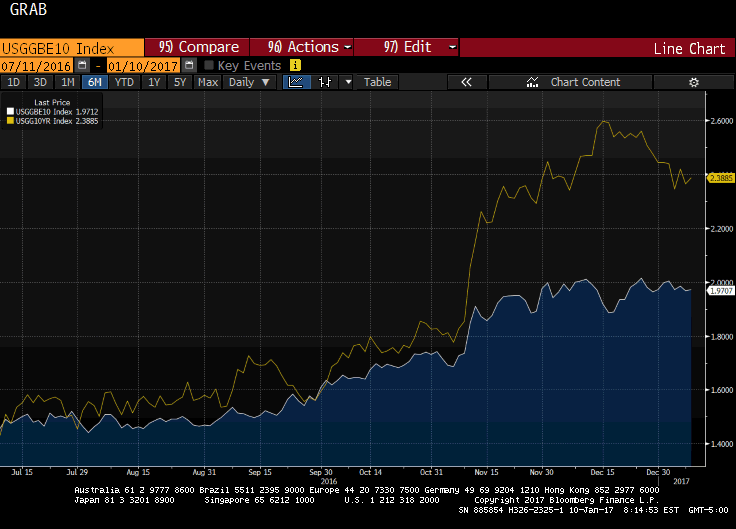| The US 10-year yield fell briefly below 1.32% last July. The yield slowly rose to reach 1.80% in mid-October. The day after the election, the yield initially slipped to almost 1.71%. This was a bit of a miscue, and the yield rose sharply to hit almost 2.64% the day after the FOMC hiked rates for the second time in the cycle on December 14. The yield backed off to hit 2.33% at the end of last week.
The difference between the conventional yield and the inflation-linked yield (TIPS), the 10-year breakeven, climbed with conventional yield until the middle of November. Since the election, the increase in the conventional bond yield has not been matched by the increase the breakeven. This is depicted in the Great Graphic here, created on Bloomberg. The yellow line is the conventional 10-year bond yield. The white line is the 10-year breakeven rate. The gap between the two shows the real rate (nominal minus inflation expectation). What is remarkable is the sharp rise in the real 10-year yields since the election. The nominal interest rate is usually thought of as having two components: the real rate and the premium. There are several factors that could be part of the premium, but it often, and especially for US Treasuries, is thought to be essentially inflation expectations. In other countries and other products (including TIPS) the premium may be more complicated. There may be a liquidity premium. There may be a political risk premium. There may be a currency premium too, for example. |
Conventional Yield and The Inflation-linked Yield |
At the end of the week, the University of Michigan will report the preliminary results of its survey of inflation expectations. It asks questions to determine the one-year inflation outlook and the 5-10 year outlook. The longer-term inflation expectations are the most relevant for policymakers. In December, the FOMC statement said that “Market-based measures of inflation compensation have moved up considerably but still are low; most survey-based measures of longer-term expectations are little changed, on balance in recent months.”
When the FOMC met, it had access to the preliminary December results. It showed a slight decline to 2.5% from 2.6%. However, before Christmas, the final report showed a decline to 2.3%. This is the lowest on record (time series goes back to 1979).
The rise in US yields since the election is not so much an increase inflation expectations but real yields. An increase in real yields could be a reflection of an increase in the demand for capital (which could come from the private and/or public sector). It could reflect anticipated changes to supply-side factors (tax cuts and regulation) that boost profitability.
Investors in fixed income products typically get the nominal returns. Our bullish view of the dollar was predicated on widening nominal interest rate differentials. We think that for portfolio investment decision, nominal rates are key. However, for understanding the economic impact of interest rates, economists may be best served by looking at real rather than nominal rates. That said, a country with high real rates and a slowing economy could spur a sharp decline in nominal yields. (bond market rally).
Full story here Are you the author? Previous post See more for Next post
Tags: #USD,Great Graphic,inflation expectations,newslettersent,real rates






































